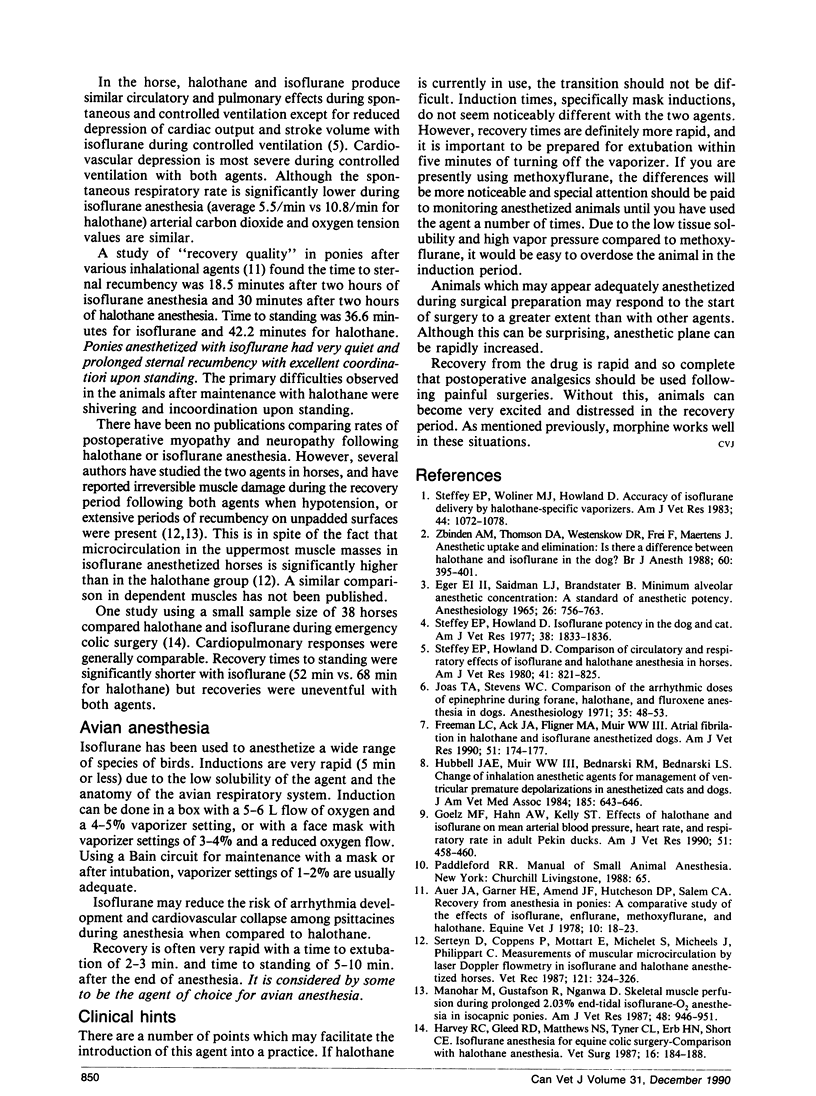Abstract
Isoflurane is the most recently available inhalational anesthetic agent on the market today. Although there have been few clinical trials comparing its use to halothane and methoxyflurane, the pharmacology of the agent suggests certain situations in which it may be the preferable agent. These include avian anesthesia, geriatric patients, patients with cardiovascular disease or hepatic disease, critically ill and unstable patients, cases such as brachiocephalics where upper airway obstruction is a concern during recovery, patients where increases in intracranial pressure should be avoided, and cesarean section. In addition, the rapid recoveries seen with isoflurane may be an advantage for outpatient surgeries.
Full text
PDF



Selected References
These references are in PubMed. This may not be the complete list of references from this article.
- Auer J. A., Garner H. E., Amend J. F., Hutcheson D. P., Salem C. A. Recovery from anaesthesia in ponies: a comparative study of the effects of isoflurane, enflurane, methoxyflurane and halothane. Equine Vet J. 1978 Jan;10(1):18–23. doi: 10.1111/j.2042-3306.1978.tb02207.x. [DOI] [PubMed] [Google Scholar]
- Eger E. I., 2nd, Saidman L. J., Brandstater B. Minimum alveolar anesthetic concentration: a standard of anesthetic potency. Anesthesiology. 1965 Nov-Dec;26(6):756–763. doi: 10.1097/00000542-196511000-00010. [DOI] [PubMed] [Google Scholar]
- Freeman L. C., Ack J. A., Fligner M. A., Muir W. W., 3rd Atrial fibrillation in halothane- and isoflurane-anesthetized dogs. Am J Vet Res. 1990 Jan;51(1):174–177. [PubMed] [Google Scholar]
- Goelz M. F., Hahn A. W., Kelley S. T. Effects of halothane and isoflurane on mean arterial blood pressure, heart rate, and respiratory rate in adult Pekin ducks. Am J Vet Res. 1990 Mar;51(3):458–460. [PubMed] [Google Scholar]
- Harvey R. C., Gleed R. D., Matthews N. S., Tyner C. L., Erb H. N., Short C. E. Isoflurane anesthesia for equine colic surgery. Comparison with halothane anesthesia. Vet Surg. 1987 Mar-Apr;16(2):184–188. doi: 10.1111/j.1532-950x.1987.tb00935.x. [DOI] [PubMed] [Google Scholar]
- Hubbell J. A., Muir W. W., 3rd, Bednarski R. M., Bednarski L. S. Change of inhalation anesthetic agents for management of ventricular premature depolarizations in anesthetized cats and dogs. J Am Vet Med Assoc. 1984 Sep 15;185(6):643–646. [PubMed] [Google Scholar]
- Joas T. A., Stevens W. C. Comparison of the arrhythmic doses of epinephrine during Forane, halothane, and fluroxene anesthesia in dogs. Anesthesiology. 1971 Jul;35(1):48–53. doi: 10.1097/00000542-197107000-00015. [DOI] [PubMed] [Google Scholar]
- Manohar M., Gustafson R., Nganwa D. Skeletal muscle perfusion during prolonged 2.03% end-tidal isoflurane-O2 anesthesia in isocapnic ponies. Am J Vet Res. 1987 Jun;48(6):946–951. [PubMed] [Google Scholar]
- Serteyn D., Coppens P., Mottart E., Michelet S., Micheels J., Philippart C., Lamy M. Measurements of muscular microcirculation by laser Doppler flowmetry in isoflurane and halothane anaesthetised horses. Vet Rec. 1987 Oct 3;121(14):324–326. doi: 10.1136/vr.121.14.324. [DOI] [PubMed] [Google Scholar]
- Steffey E. P., Howland D., Jr Comparison of circulatory and respiratory effects of isoflurane and halothane anesthesia in horses. Am J Vet Res. 1980 May;41(5):821–825. [PubMed] [Google Scholar]
- Steffey E. P., Howland D., Jr Isoflurane potency in the dog and cat. Am J Vet Res. 1977 Nov;38(11):1833–1836. [PubMed] [Google Scholar]
- Steffey E. P., Woliner M. J., Howland D. Accuracy of isoflurane delivery by halothane-specific vaporizers. Am J Vet Res. 1983 Jun;44(6):1072–1078. [PubMed] [Google Scholar]
- Zbinden A. M., Thomson D. A., Westenskow D. R., Frei F., Maertens J. Anaesthetic uptake and elimination: is there a difference between halothane and isoflurane in the dog? Br J Anaesth. 1988 Mar;60(4):395–401. doi: 10.1093/bja/60.4.395. [DOI] [PubMed] [Google Scholar]


